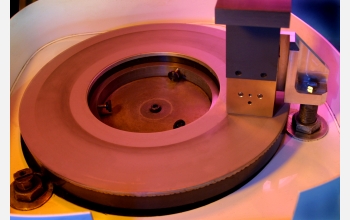Multimedia Gallery
Environmentally Friendly Fluid (Image 3)
This "lapping" machine was used to evaluate fluids during research that engineered a new, environmentally friendly fluid for use with ceramic polishing. The fluid was derived in part from green tea. The chemical is part of a slurry that polishes the ceramics--made from aluminum oxide and titanium carbide--used in computer hard-drive, read-write heads. Researchers mount computer harddrive, read-write heads in the brass, T-shaped attachment on the right side of the machine. Weights apply pressure to the "T" and to the read-write head specimen. The researchers measure the sample weight change before and after.
This research was supported by a National Science Foundation (NSF) Small Business Innovation Research (SBIR) Phase I grant (DMI 03-19794), awarded to John Lombardi of Ventana Research Corporation in Tucson, Ariz. Lombardi received the award to develop high-performance, environmentally benign lapping fluids for hard-drive manufacturing applications.
More about this Image:
The new, biodegradable machining compound for computer hard-drive manufacturing is three- to four-times more effective than toxic counterparts, and is part of a family of machining fluids that bind to polishing debris and rapidly remove tiny particles from the polishing surface. The fluids are critical because imperfections in read-write heads must be less than 10 angstroms high--larger defects can cause the head to crash into the disk, causing data loss. Ventana formulates its fluid using a combination of synthetic proteins derived from common commercial chemicals and compounds extracted from green tea and other plants. The plant chemicals in the new fluid (the same ones that form stains in coffee pots and drinking mugs) are abundant and easily extractable, and they give the new fluid its ability to bind to the particle debris formed while polishing read-write heads.
Lombardi hopes the fluid's possible biocompatibility and high affinity for ceramics and metals may lead to applications in wastewater treatment (to remove heavy-metal contaminants) and medicine (the compound may have advantages in delivering certain cancer treatments).
NSF awards SBIR grants to small businesses for risky, novel research with a potential for commercialization. Through SBIR and the related Small Business Technology Transfer (STTR) programs, NSF encourages partnerships between the small business and the academic sectors to develop a technology base for commercialization.
This excerpt was taken from NSF Press Release PR 04-053, released April 19, 2004. The complete release is available Here. (Year of image: 2003)
Credit: Erica von Koerber, Evon Photography (Tucson, Ariz.)
See other images like this on your iPhone or iPad download NSF Science Zone on the Apple App Store.
Images and other media in the National Science Foundation Multimedia Gallery are available for use in print and electronic material by NSF employees, members of the media, university staff, teachers and the general public. All media in the gallery are intended for personal, educational and nonprofit/non-commercial use only.
Images credited to the National Science Foundation, a federal agency, are in the public domain. The images were created by employees of the United States Government as part of their official duties or prepared by contractors as "works for hire" for NSF. You may freely use NSF-credited images and, at your discretion, credit NSF with a "Courtesy: National Science Foundation" notation.
Additional information about general usage can be found in Conditions.
Also Available:
Download the high-resolution TIFF version of the image. (9.3 MB)
Use your mouse to right-click (Mac users may need to Ctrl-click) the link above and choose the option that will save the file or target to your computer.



